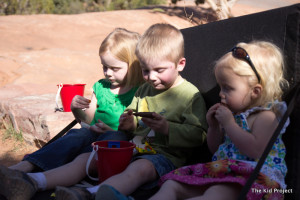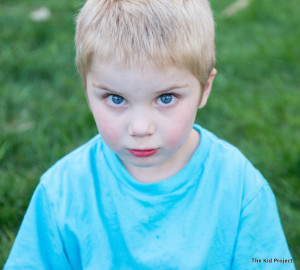One silly little post on fear… and it has erupted into a series. Should I call it a mini-series? Ha ha! Earlier this week I opened up about my new climbing buddy – Mr. Freak-out himself. And the little things I have done to help fight him. Today we are moving on to our kids and fear. I am passionate about teaching my kids to confront and fight their fears. Whether fear of heights or fear of the dark. Today we discuss the question, “what is normal and what is not?”
 My husband and I glanced at each other, giddy like school kids. We were there. Moab, UT. One of our favorite places on earth and we had told our kids all week about how you could ride your bikes on the rocks, see endless starts at night, and hike to amazing locations.
My husband and I glanced at each other, giddy like school kids. We were there. Moab, UT. One of our favorite places on earth and we had told our kids all week about how you could ride your bikes on the rocks, see endless starts at night, and hike to amazing locations.
We jumped out of the Xterra, followed by three little kids, gawking at the land around us. Then…a squeal. A scream. A terrified clawing at my leg as my five year old literally climbed into my arms. I was not pleased. This was not the response I had hoped for.
What was wrong? Bugs. Yes, bugs.
I did everything wrong in the book, according to the experts. I told her she was being ridiculous, that she was fine and set her on the picnic table to “finish out her fussing” while we finished unloading. By the end of the trip she was making homes for these same bugs…so I guess we didn’t do any lasting damage.
Kids have all sorts of fears. According to Kidshealth.org, many of the fears are natural stages that children progress through as they develop:
-
 Babies experience stranger anxiety, clinging to parents when confronted by people they don’t recognize.
Babies experience stranger anxiety, clinging to parents when confronted by people they don’t recognize. - Toddlers around 10 to 18 months old experience separation anxiety, becoming emotionally distressed when one or both parents leave.
- Kids ages 4 through 6 have anxiety about things that aren’t based in reality, such as fears of monsters and ghosts.
- Kids ages 7 through 12 often have fears that reflect real circumstances that may happen to them, such as bodily injury and natural disaster.
But as parents, what do we do with these fears? Often, the child needs a little guidance along the way to “developing” out of it. Here are a few things we have noticed:
1.
 Each child is different and no manner of comparison is going to change that. I shared a story of us encountering two very different tolerances for heights between our first and second child. You can read that post here: Each child is different. Assess each kid independently.
Each child is different and no manner of comparison is going to change that. I shared a story of us encountering two very different tolerances for heights between our first and second child. You can read that post here: Each child is different. Assess each kid independently.
2. Talking about the fear can help a child move past it… or rather we need to listen to how they feel. “Be quick to listen, slow to speak” [James 1:19]. Sometimes a little dialogue can help them learn to distinguish between “afraid”, “nervous” and “worried.” And teach them to express themselves better.
For example, I began to notice that every time my oldest daughter went to a class [swimming, dance, gymnastics] she’d say she felt like she was sick and scared. I didn’t know what to make of it. She was happy to go all day. She wanted to go. But minutes before we’d arrive she’d become quiet, reserved, and unwilling. Through dialogue I helped her to see that sometimes being excited made you feel the same as being nervous – which all resulted in sick-ish feelings…upset stomach, tight throat, shaky hands. Once she learned that these things would end the moment class began, she was able to logic through it.
3. We can help our children by not being afraid to look at our own lives, acknowledge our fears and learn to walk through those fears.
Learning Place Online suggested a few others I appreciated:
-
 The child can also learn some positive self-statements, such as “I can do this” and “I will be OK” to say to himself or herself when feeling anxious. Relaxation techniques are helpful, including visualization (of floating on a cloud or lying on a beach, for example) and deep breathing (imagining that the lungs are balloons and letting them slowly deflate).
The child can also learn some positive self-statements, such as “I can do this” and “I will be OK” to say to himself or herself when feeling anxious. Relaxation techniques are helpful, including visualization (of floating on a cloud or lying on a beach, for example) and deep breathing (imagining that the lungs are balloons and letting them slowly deflate). - Begin introducing whatever they are afraid of slowly: If they are afraid of dogs, first read several picture books on puppies. Then walk by a pet store window. Then walk into the pet store and look at the puppies in cages. Then have your child watch you hold and pet a puppy. Finally, ask your child to pet the puppy when you are holding it. The key to this technique is being very patient and praising all of your child’s efforts to overcome their fear.
You gain strength, courage, and confidence by every experience in which you really stop to look fear in the face. You must do the thing which you think you cannot do.
Eleanor Roosevelt
What are your stories? Have your own kids had victory over some of their fears? And if so, how?
For more info on outdoor phobias check out this weeks post from Outside Mom: Are you hindered by outdoor paranoia?

Pingback: When fear is called for…[Dealing with Extreme Weather] | | Kid Project.orgKid Project.org